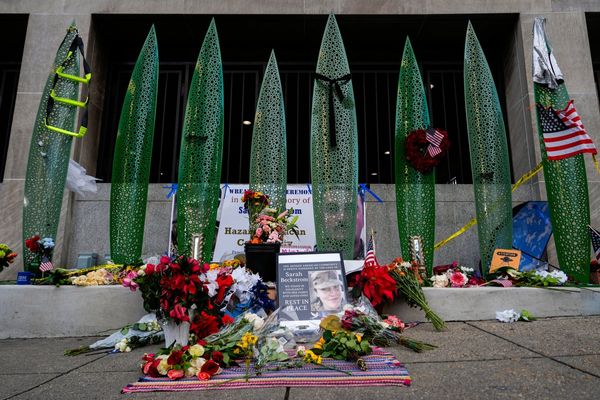
Warning: The story below contains references to suicide. The National Suicide Prevention Lifeline is available at 1-800-273-8255.
Los Angeles, California, US – Kevin McCarthy says one memory from his time in solitary confinement at California’s notorious Pelican Bay State Prison remains especially vivid, even years later.
“I was being held in a cell for more than 23 hours a day and hadn’t seen anything but the colour gray,” McCarthy told Al Jazeera over the phone in a recent interview. “And then as they were transferring me to another unit of the prison, they walked me outside and I saw this tree, and it was so green.
“It was so vivid that it was an almost psychedelic experience.”
McCarthy, now 41, was released from prison in July 2020 after spending nearly a decade in solitary confinement, kept in a cell about the size of a small parking space for more than 22 hours a day.
A bill known as the California Mandela Act, passed by the state legislature last month, would have limited the practice to no more than 15 consecutive days and banned its use for vulnerable people, such as pregnant women and those with physical and mental disabilities, among others.
But Governor Gavin Newsom vetoed the proposal late on Thursday, in a move that was decried by advocates who have said that thousands of people are languishing in California’s prisons and jails in conditions that a United Nations expert said can amount to torture.
What is solitary?
Solitary confinement is commonly defined as being held in a cell for more than 22 hours a day without meaningful social interaction. The practice has been linked to a heightened risk of suicide, depression, and irritability, as well as post-traumatic stress disorder (PTSD) and a number of physical issues, such as hypertension and heart attacks.
According to the Vera Institute (PDF), a progressive criminal justice organisation, a study of the use of solitary in New York’s prisons found that those held in isolation units died by suicide at a rate five times higher than people held in regular prison facilities.
After 15 consecutive days, the practice violates the United Nations’s Mandela Rules on the minimum treatment of prisoners, and the UN Special Rapporteur on torture has called for the “absolute prohibition” of solitary beyond that time period.
Various provisions of the California bill were inspired by recent solitary cases that drew condemnation in the state, such as the death of Choung Woong Ahn, a 74-year-old Korean immigrant who died by suicide in a solitary unit at an immigrant detention centre in 2020.
The California Department of Corrections and Rehabilitation (CDCR) did not respond to questions from Al Jazeera regarding the use of solitary in the state prison system, and stated it does not comment on pending legislation.
We are disappointed in this news but not suprised. We will not stop fighting! https://t.co/eaEZQppyUT https://t.co/K5uY3KZqwa
— Immigrant Defense Advocates (IDA) (@CA4ImmiJustice) September 30, 2022
The department previously said the bill would have resulted in expensive renovations to prison yards to accommodate people released from solitary, and remove a key tool for isolating dangerous individuals inside prison. Both those arguments have been disputed by advocates.
But Governor Newsom echoed the CDCR’s concerns in a message accompanying his veto this week. In a statement (PDF), Newsom said the bill would “categorically prohibit the placement of large portions of the incarcerated population in segregated housing – even if such a placement is to protect the safety of all incarcerated individuals in the institution”.
‘The Wild West’
But some studies have found that solitary does little to make carceral facilities safer, and across the United States, states and municipalities have taken steps to roll back its use.
According to a survey by the Arthur Liman Center for Public Interest Law at Yale Law School, 15 US states enacted laws reforming or limiting the use of solitary confinement between 2018 and 2020.
“A decade ago there were very few proposals to limit the use of solitary. But now there’s no doubt there’s a growing movement in that direction,” said Judith Resnik, an Arthur Liman professor of law at Yale Law School.
But the practice nevertheless remains a common feature of the US prison system.
People held in restricted prison conditions account for about 3.4 percent of the US prison population, although the average can vary greatly by state. And according to the Yale Law School survey, at any given time US prisons still have an average of nearly 50,000 people housed in solitary confinement for more than 15 consecutive days.
Those figures do not include people held in solitary in detention centres and county jails, which typically house lower-level offenders but are not required to keep records on the number of people they have in solitary confinement.
Hamid Yazdan Panah, a lawyer with Immigrant Defense Advocates who helped promote the Mandela Act, said that California currently has about 4,000 people in prolonged isolation – more than 15 consecutive days.
“It’s almost certainly an undercount,” said Panah. “The number is probably at least twice as high.”
But the state does not have a shared definition of the practice, which makes getting accurate figures on its use even more difficult.
“Because there’s no statewide definition, it’s not rare to inspect a jail that will have numerous people in solitary-style conditions and the authorities there will earnestly tell you they don’t have anyone in solitary,” said Margot Mendelson, legal director at the Prison Law Office, a group that advocates for the rights of incarcerated people.
Mendelson said that while solitary is commonly described as a tool for separating the most dangerous people in a facility from the general population, it is used for a wide variety of reasons, including warehousing people with mental health issues.
“The use of solitary in California’s county jails is shockingly common, unregulated, and opaque,” Mendelson told Al Jazeera. “It’s the Wild West.”
Substantial reforms
The Mandela Act, named after South African anti-apartheid campaigner and former President Nelson Mandela, would have implemented substantial reforms to the use of solitary confinement in California, without banning it entirely.
Among other provisions, the proposal would have prohibited the use of solitary for people under age 26 and over age 59, as well as limited the practice to 15 consecutive days and 45 days in total over a 180-day period.
It would also have created a statewide definition of solitary confinement that would apply in jails, prisons, and privately run detention facilities throughout the state, and would require more rigorous documentation of its use.
Panah said it would have reduced the state’s use of solitary by as much as 80 percent. And while other states such as New York have passed legislation to decrease the use of solitary, California would have been the first to apply such reforms to immigrant detention centres.
While advocates expressed disappointment with Newsom’s decision, they believe the push to end solitary confinement will continue to gain momentum.
“There are certain things we as a society have decided are unacceptable. Torture is one of them,” said Panah. “If we’re going to be a just society, prolonged isolation is not a practice we should condone.”







